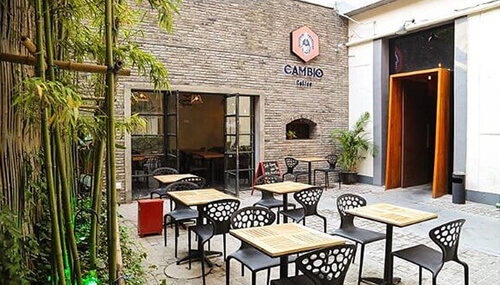U.S.-Asia Business
For Chinese Millennials, Coffee Is Becoming a Lifestyle
By

The race is on for who can keep Chinese consumers the most caffeinated.
Coffee is on track to overtake tea as China’s drink of choice. According to Coffee Business Intelligence, China’s coffee consumption growth rate is about 20 percent—2 percent higher than the global growth rate. Of those coffee consumers, millennials in China’s growing middle class demographic comprise an overwhelming 75 percent. Considering that China’s middle class is set to double to 600 million people by 2022, there is huge potential for China’s coffee market to grow even further.
“It’s so amazing how the coffee culture in China changed in the past 10 years,” marvels Charlie Gu, self-described coffee enthusiast and CEO of marketing agency Kollective Influence. “Back then, people didn’t even know how to make coffee—Chinese people were only exposed to instant coffee from Nestle.”

China’s coffee consumption growth rate is about 20 percent—2 percent higher than the global growth rate.
Ever since Starbucks opened its first storefront in Beijing in 1999, the number of coffee shops in China has ballooned. Starbucks alone currently has 3,400 outlets in China (the country is Starbucks’ second-largest market, after the United States) and plans to have 6,000 stores by 2022. Luckin Coffee, a Chinese company that launched operations only in January 2018 but already is Starbucks’ main competitor in China, has seen explosive growth, thanks to its strategy of cheap and fast coffee delivery: Luckin currently operates in 21 Chinese cities and 1,400 outlets, with plans to grow to 6,000 stores by 2020. China’s coffee industry offers plenty of opportunities for growth, and it doesn’t seem to be slowing down anytime soon.
Coffee as a lifestyle
The first time Gu bought Starbucks coffee bean grinds, he thought it was meant to be drunk like instant coffee, since that was all he knew at that time. “I took a scoop of the coffee and put it in water,” he laughs. “I thought you were supposed to just drink it like that, with a mouthful of grinds.” However, Gu learned quickly and soon developed a taste for coffee—he even became “that guy” at work who would bring his own coffeemaker to the office.
“Now, fast forward: even my dad has an Italian espresso machine,” says Gu. “He drinks coffee every day, at least two to three cups. It’s so amazing how everyone is embracing that.”
Coffee consumption has adopted its own social connotations in China. Sebastian Martin, founder and CEO of Shanghai-based Cambio Coffee, speculates that part of the reason coffee is so popular nowadays is because of the socioeconomic signifiers of the Starbucks brand. “Initially, it wasn’t so much about the coffee,” explains Martin. “It was like, ‘Ok, I want some Starbucks, and here’s my Starbucks cup,’ and this signals something about my status and my cosmopolitan sense of identity.”
A country of maturing coffee consumers
While Starbucks is still immensely popular, Gu emphasizes that many consumers no longer think of coffee purely as a status symbol. “It has become an integral part of many Chinese people’s lifestyles,” he says. “Many are genuinely interested in drinking and appreciating coffee.”
Although both Gu and Martin credit Starbucks with initial exposure to coffee culture in China, independent coffee shops have also been on the rise, particularly in Tier 1 cities like Shanghai and Beijing where the consumers tend to be more mature.
China is also developing its own coffee-growing industry…Starbucks debuted its first single-origin Yunnan coffee in 2017.

“I think the go-to for a lot of café owners is just to make their shop really different or cool,” says Martin. “It’s a bit gimmicky—a lot of flowers or toys.” Martin uses Shanghai-based Mellower Café as an example: Although the café offers the typical coffee and espresso drinks popular in the West, Mellower became really popular because of its drink called “Sweet Little Rain,” which came with a cloud of cotton candy suspended over the coffee cup. “The steam would melt it, and it would drip into the coffee,” he says. “Especially girls, they loved that, and they would all go and take pictures—but it was more like a fad.”
However, Gu emphasizes that Chinese consumer tastes have already rapidly shifted and points to Starbucks’ strategy as a prime example. “When they first launched in China, their big strategy was promoting Frappuccinos, which isn’t coffee but were super popular,” he explains. “But these days, if you go to Starbucks, the Frappuccino is not at the front of the line.” Instead, Gu says that people are more interested in more “coffee-centric” drinks like nitro cold brews.
Regional differences in coffee consumption
Despite these changes, it is important to note that coffee tastes will vary by region and that what is popular in the West has not yet hit mainstream in China.

China’s coffee industry offers plenty of opportunities for growth, and it doesn’t seem to be slowing down anytime soon.
“The interesting thing about China is that it’s all happening at the same time,” says Martin about China’s nascent coffee culture. “In the West, there was this first wave, second wave, third wave. Since China opened up…the waves have all kind of happened at the same time.”
Martin explains that, outside of the big cities, the majority of coffee consumption is still instant coffee. In some lower tier cities, Starbucks may still just be entering and exposing people to their first coffee shop experience. “But if you go into Shanghai or Beijing, you have tons of specialty ‘hipster’ shops,” he says. “There’s this mishmash of different cultures and trends happening at the same time.”
Yet even in big cities, coffee consumption still differs vastly from the United States, and prospective business owners should take note. When Martin opened his first Cambio Coffee café in Shanghai, he had assumed he would easily hit 300-400 daily orders, the same as a relatively small café in the United States, but quickly had to readjust his business plan. “When I first arrived, I thought we were going to hit those kinds of numbers,” he admits. “But then I started meeting other coffee shop owners, and they said you’re doing well if you’re doing 100-150. The average independent café...a lot of them are struggling.”
Gu adds that the most successful brands are the ones that take the time to develop relationships with their customers. “Smart brands also take the time to educate their consumers,” he believes. “In China, this kind of education is much-needed and will help brands grow.”
The future of Chinese coffee
Despite the difficulties of owning a coffee shop in China, there are still ways to appeal to the customer. For Cambio Coffee, a big hook is their branded coffee blends. “We’re one of the few 100 percent organic-certified coffee brands,” says Martin. As a result, they managed to get organic supermarket chain Green & Safe as a client. “Because of the food safety trends and food scandals in China, there was more need for imported products that were perceived to be safer or higher quality,” he adds.
Although most people associate coffee with Latin American countries, China is also developing its own coffee-growing industry—Cambio sources some of its beans from the Yunnan region, which Martin describes as very palatable to Chinese tastes. Even Starbucks debuted its first single-origin Yunnan coffee in 2017.

“I think there’s so much potential (in Yunnan) ... The terroir, the growing conditions, are really apt for coffee. It’s going to be a real global competitor.”
“I think there’s so much potential (in Yunnan),” Martin says. “The terroir, the growing conditions, are really apt for coffee. It’s going to be a real global competitor.”
As for whether or not consumers in China—and around the world—are ready for Chinese coffee remains to be seen, but Gu has high hopes.
He points to the growing sense of national pride as a main driver, particularly among Gen Z consumers, but also Chinese consumers’ adaptability. “One thing about Chinese consumers—they’re very quick to adapt to new things,” says Gu. “China was very poor up until very recently, so consumers really have no history of using these things. Everything is novelty, so they’re willing to try new things.”

